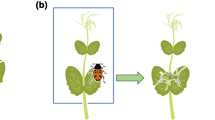Summary
Pea aphids have several alternative responses to the detection of alarm pheromone produced by conspecifics. One of these, dropping from the feeding site to the ground, is potentially costly owing to the risk of desiccation-induced mortality on the ground before another host plant can be reached. Both dropping and walking from the feeding site incur a cost due to lost feeding opportunity. The aphids' decision as to which anti-predator tactic to use should be sensitive to the costs of their behaviour. Consequently, aphids should be less likely to drop when the risk of desiccation is higher, and less likely to drop or walk when the lost opportunity cost is higher. We tested these predictions by manipulating climatic severity (temperature and humidity) and host quality, respectively. As predicted, aphids are less likely to drop or walk in response to pheromone when feeding on high quality than on low quality hosts, and less likely to drop when the environment is hot and dry than when it is more benign. The latter is true whether the aphids are feeding on real or simulated leaves. Since all aphids were of the same clone, these results show that individual aphid genotypes possess the ability to adaptively modify their escape behaviour with changes in prevailing conditions. A number of other behavioural observations in the aphid literature may be interpreted in an economic or cost-benefit framework. The approach holds considerable promise for understanding many aspects of the anti-predator behaviour of aphids and other animals.
Similar content being viewed by others
References
Auclair JL (1965) Feeding and nutrition of the pea aphid, Acyrthosiphon pisum (Homoptera: Aphidae), on chemically defined diets of various pH and nutrient levels. Ann Entomol Soc Am 58:855–875
Bowers WS, Nault LR, Webb RE, Dutky SR (1972) Aphid alarm pheromone: isolation, identification, synthesis. Science 177:1121–1122
Brodsky LM, Barlow CA (1986) Escape responses of the pea aphid, Acyrthosiphon pisum (Harris): influence of predator type and temperature. Can J Zool 64:937–939
Bunting S, van Emden HF (1980) Rapid response to selection for increased esterase activity on small populations of an apomictic clone of Myzus persicae. Nature 285:502–503
Clegg JM, Barlow CA (1982) Escape behaviour of the pea aphid Acyrthosiphon pisum (Harris) in response to alarm pheromone and vibration. Can J Zool 60:2245–2252
Dill LM (1990) Distance-to-cover and the escape decisions of an African cichlid fish, Melanochromis chipokae. Envir Biol Fishes 27:147–152
Dill LM, Houtman R (1989) The influence of distance to refuge on flight initiation distance in the gray squirrel (Sciurus carolinensis). Can J Zool 67:233–235
Dill LM, Ydenberg RC (1987) The group size — flight distance relationship in waterstriders (Gerris remigis). Can J Zool 65:223–226
Herger P (1975) Einfluss von Farbe und Nahrungszusammensetzung auf das Saugverhalten der künstlich ernährten Ampferblattlaus, Aphis rumicis (Homoptera: Aphididae). Entomol Germanica 2:149–166
Houston A, Clark C, McNamara J, Mangel M (1988) Dynamic models in behavioural and evolutionary ecology. Nature 332:29–34
Kislow CJ, Edwards LJ (1972) Repellent odour in aphids. Nature 235:108–109
Mittler TE (1967) Gustation of dietary amino acids by the aphid Myzus persicae. Entomologia Exp Appl 10:87–96
Mittler TE, Dadd RH (1964) Gustatory discrimination between liquids by the aphid Myzus persicae (Sulzer). Entomologia Exp Appl 7:315–328
Montgomery MF, Nault LR (1977a) Comparative response of aphids to the alarm pheromone, (E)-β-farnesene. Entomologia Exp Appl 22:236–242
Montgomery ME, Nault LR (1977b) Aphid alarm pheromones: dispersion of Hyadaphis erysimi and Myzus persicae. Ann Entomol Soc Am 70:669–672
Montgomery ME, Nault LR (1978) Effects of age and wing polymorphism on the sensitivity of Myzus persicae to alarm pheromone. Ann Entomol Soc Am 71:788–790
Müller FP (1983) Differential alarm pheromone responses between strains of the aphid Acyrthosiphon pisum. Entomologia Exp Appl 34:347–348
Nault LR, Phelan PL (1984) Alarm pheromones and sociality in pre-social insects. In: Bell WJ, Cardé RT (eds) Chemical Ecology of Insects. Chapman and Hall Ltd., New York, pp 237–256
Nault LR, Edwards LJ, Styer WE (1973) Aphid alarm pheromones: secretion and reception. Environ Entomol 2:101–105
Niku B (1975) Verhalten und Fruchtbarkeit ungeflügelter Erbsenläuse (Acyrthosiphon pisum) nach einer Fallreaktion. Entomologia Exp Appl 18:17–30
Roitberg BD, Myers JH (1978) Adaptation of alarm pheromone responses of the pea aphid Acyrthosiphon pisum (Harris). Can J Zool 56:103–108
Roitberg BD, Myers JH (1979) Behavioural and physiological adaptations of pea aphids (Homoptera: Aphididae) to high ground temperatures and predator disturbance. Can Ent 111:515–519
Roitberg BD, Myers JH, Frazer BD (1979) The influence of predators on the movement of apterous pea aphids between plants. J Anim Ecol 48:111–122
Srivastava PN, Auclair JL (1974) Effect of amino acid concentration on diet uptake and performance by the pea aphid, Acyrthosiphon pisum (Homoptera: Aphididae). Can Ent 106:149–156
Stamp NE, Bowers MD (1988) Direct and indirect effects of predatory wasps (Polistes sp.: Vespidae) on gregarious caterpillars (Hemileuca lucina: Saturniidae). Oecologia 75:619–624
Whitham TG, Williams AG, Robinson AR (1984) The variation principle: individual plants as temporal and spatial mosaics of resistance to rapidly evolving pests. In: Price P, Slobodchikoff C, Gaud W (eds) A New Ecology: Novel Approaches to Interactive Systems. John Wiley and Sons, New York, pp 15–51
Wiener LF, Capinera JL (1979) Greenbug response to an alarm pheromone analog: temperature and humidity effects, disruptive potential, and analog releaser efficacy. Ann Entomol Soc Am 72:369–371
Ydenberg RC, Dill LM (1986) The economics of fleeing from predators. Adv Study Behav 16:229–249
Author information
Authors and Affiliations
Rights and permissions
About this article
Cite this article
Dill, L.M., Fraser, A.H.G. & Roitberg, B.D. The economics of escape behaviour in the pea aphid, Acyrthosiphon pisum . Oecologia 83, 473–478 (1990). https://doi.org/10.1007/BF00317197
Received:
Accepted:
Issue Date:
DOI: https://doi.org/10.1007/BF00317197




